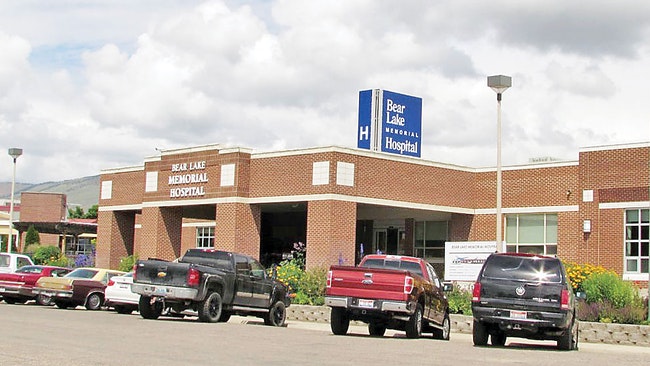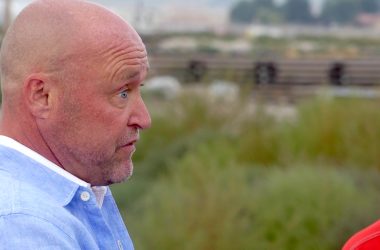
Bear Lake Memorial Hospital in Montpelier, Idaho, serves an Idaho county that has recorded only 15 cases of Covid. The county is situated in southeast Idaho. (Bear Lake County News-Examiner photo)
[ EDITOR’S NOTE: This project was produced in partnership with the Solutions Journalism Network as part of the Enterprise’s effort to take a fresh approach to reporting community issues. ]
ONTARIO – Rural, secluded counties in Oregon and Idaho appear to be able to evade the latest wave of Covid infections even as cases of the malady continue to mount in Malheur County.
Two Oregon counties depressed the spread of Covid so well that Gov. Kate Brown recently removed them from the state watchlist of counties where the virus is out of control.
Meantime, Malheur County continues to report new infections it can’t trace to a source, more deaths and more people so seriously ill with the virus they need hospitalization.
The county’s experience isn’t just a complex chain of numbers. State and county officials recently again restricted gatherings. School officials who spent the summer planning to get children back in classrooms are announcing one after another that won’t happen soon.
Through interviews and an analysis of data from the West, the Enterprise identified counties where the virus isn’t on a rampage – and what steps those counties took to keep it contained. The research found four factors impacting the local impact:
• A strong attitude of compliance with state and federal social distancing guidelines.
• Rapid mitigation efforts when the virus first appeared on American shores.
• Low population density.
• The relative isolation of the counties.
Wheeler County, for example, is the least populated county in Oregon with about 1,300 residents and it also has yet to record a positive Covid case, mainly because of its secluded location.
“I would say that is a big factor. There are very few of us,” said Karen Woods, program coordinator for the Wheeler County Health Department.
Woods said the independent nature of Wheeler County’s residents proved important as the Covid epidemic spread.
Woods said an old joke about the cowboy and social distancing illustrates the prevailing attitude in the county. When told to keep at least six feet of distance between himself and another person, an old cowboy asked, “Six feet, isn’t that a little close?”
“But that attitude made a difference too. People want their physical space,” said Woods.
Swift efforts to diminish the spread of the virus also played a big part in the county’s lack of Covid cases, said Woods. When the governor issued her stay home order in March, Woods said the county reacted fast.
“We had conferences with our emergency management from the get-go. In one of our early conferences we decided that it would be wise for everyone to wear masks at our grocery stores,” said Woods.
More than 400 miles from Wheeler County, Idaho’s Camas County has recorded just one Covid case so far and its low population density – 0.8 people per square mile – is the key, said Brianna Bodily, public information officer for South Central Public Health District in Twin Falls.
“Camas does not have very many people. People who do go to Camas County go to recreate on their own and find their own entertainment so that definitely helps a lot,” said Bodily.
Prompt mitigation efforts – such as education programs on social media and coordination with first responders and elected officials – also paid off, said Bodily.
“We were reaching out and meeting with community leaders well before a COVID-19 case was identified. We worked very hard and very fast and people were very invested in the beginning,” said Bodily.
The initial, unified public determination to battle the virus was also an important step toward a flattened Covid curve, said Bodily.
“Everyone was in it together,” said Bodily.
The Covid virus has yet to invade Idaho’s rural Butte County, about 80 miles east of Camas County, and one reason the malady failed to grip the rural area was robust cooperation from residents, said Maggie Mann, Southeastern Idaho Public Health director.
“More vulnerable populations really took the stay-at-home order at heart. They took it seriously. In Butte County, most people are wearing masks,” said Mann.
Southeastern Idaho Public Health serves nine, mostly rural, counties in eastern Idaho, including Butte and the sparsely-populated nature of the area – like Wheeler County – is key, said Mann.
“Most of our counties are largely rural and people are able to spread out,” said Mann.
About 2,500 people live in Butte County.
The timing of the arrival of the virus was also crucial, said Mann.
“Idaho was one of the last four states in the country to have a confirmed case and we had a little more time to plan and get messaging out. I think that helped,” said Mann.
At least one anomaly, though, exists in Idaho with Covid cases, said Mann.
Bear Lake County, in the southeastern corner of the state, sits across the border from Utah’s Cache County and Logan, a city of more than 50,000 people. While the two counties share a border, they also share people who work or live in one state and travel to another.
Mann said the cross-border traffic created the potential for Covid to infiltrate Bear Lake County and produce a spike in cases, yet that hasn’t happened.
Bear Lake County, with a population of just over 6,000 people, reported 15 total cases of Covid Monday, Aug. 10. The county reported its first case in June.
In contrast, Cache County reported more than 1,900 total Covid cases Aug. 10.
“I think that is both interesting and surprising. I don’t have a good explanation,” said Mann.
Up the road from Malheur County, officials in Union County had reason to celebrate recently, when the governor took the county off the watch list. The county, with La Grande as its county seat, joined Malheur County when the watch list was announced July 3.
Through the week ending Saturday, Aug. 8, Malheur County was seeing positive virus tests in about one out of five people tested. In Union County, the rate was about one out of 20. The overall infection rate was 236 per 10,000 population in Malheur County compared to 147 per 10,000 in Union County.
Carrie Brogoitti, Union County Public Health administrator, said “there are probably a lot of factors that contribute to this so it is difficult to answer.”
“I suspect a large factor is that some counties have had most of their cases tied to outbreaks that don’t end up leading to significant community spread and some counties have widespread community transmission,” said Brogoitti.
Paul Andreas, Union County commissioner, said two things helped the county after it hit a Covid case boost in mid-June.
“When we had the big spike, I think it was a wake-up call for everybody. I think a lot of folks got complacent. We got the big spike and we realized it can happen anywhere,” said Andreas.
The second factor, said Andreas, was the county’s decision to move from Phase II to Phase I of the governor’s reopening plan. The county announced the switch June 17.
“That signaled to people we were serious about the outbreak and we were going to do what was needed to make sure our citizens were safe,” said Andreas.
Another challenge for Malheur County officials is the shared border with more populous counties in Idaho.
That proximity to Canyon, Payette and Washington counties did play a pivotal role in the number of local Covid cases said Sarah Poe, Malheur County Health Department director.
“We are near a large population center out of Boise,” said Poe.
That means, said Poe, the county with a population of 30,000 people can’t be considered independently from its Idaho neighbors regarding Covid. Malheur County is actually part of a greater southwestern Idaho community which means the impact from the virus in a place like Ada County – home of Boise – can be felt in Ontario.
As of Monday, Payette and Canyon counties were listed by Idaho authorities as in the “red” category, meaning the virus is out of control. Monday Payette County recorded 384 total Covid cases while Washington County registered more than 200.
Also, as of Monday, Malheur County logged 800 total Covid cases.
“Between Canyon, Ada, Payette and Washington counties we are closer to three quarter of a million people. So that matters. With more people in Malheur County from Idaho than reside here it absolutely impacts our cases. It’s how many people you have, that’s a big part of it. It is just a much higher risk,” said Poe.
Poe said Malheur County completed many of the steps such as education and careful coordination with health providers and official’s other counties did.
Poe said one factor in the number of cases in Malheur County was a lack of compliance with social distancing guidelines. Federal and state officials have been urging people to wear masks, avoid large gatherings, and keep a distance of 6 feet from other people.
“What is difficult is we are asking people to take personal responsibility instead of the government mandating. So, if you are against government mandates you need to take personal responsibility,” said Poe.
Poe said the Covid epidemic isn’t a simple problem.
“It is an intersection of both the economy, and business and politics and health care providers and public health. Everyone is coming at this with their own information and we have to work together to find solutions,” said Poe.
Poe said there is a light at the end of the tunnel – if the public cooperates.
“I realize people are weary. But, at any given time, we are a few weeks away or a month away from being done with this thing if behaviors change,” said Poe.
News tip? Contact reporter Pat Caldwell at [email protected] or 541-235-1003.
[NOTE: The Enterprise is providing free access to local stories concerning the pandemic. You can help provide this service by subscribing. ]




